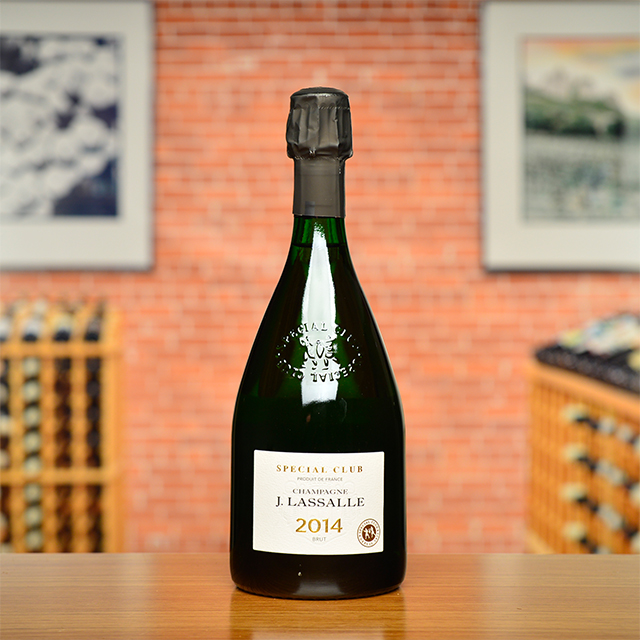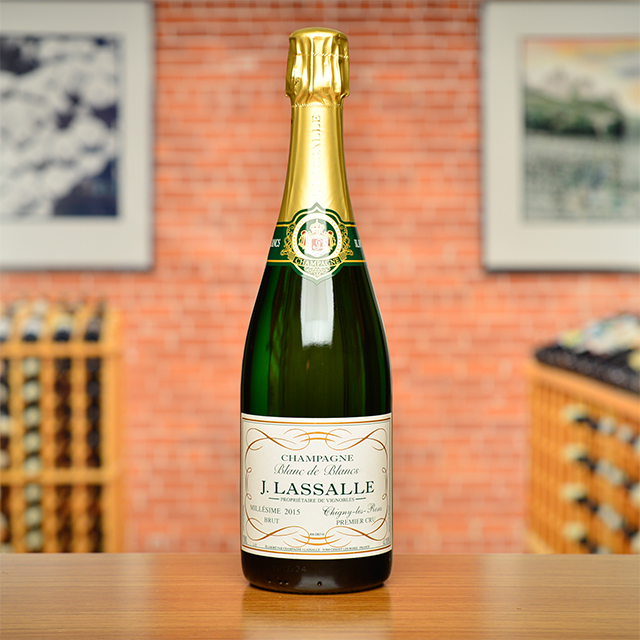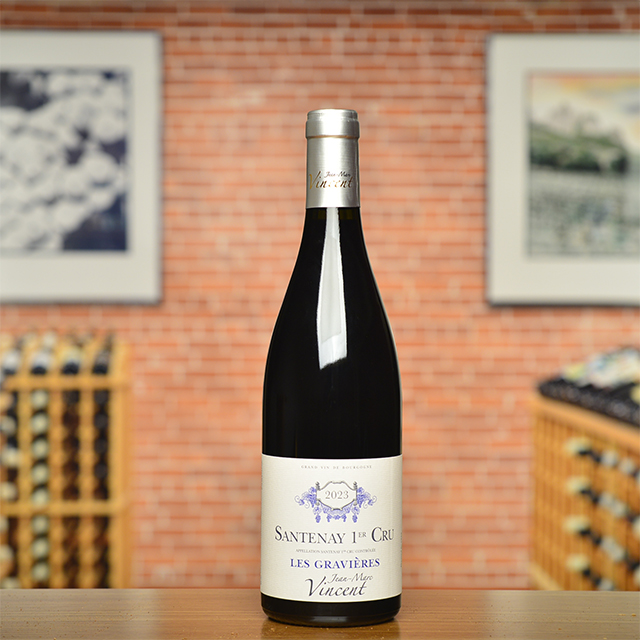Notify me
2012 Brut 1er Cru “Special Club”
J. Lassalle
Lassalle’s Champagnes tell a family story that can be traced back to founder Jules Lassalle, grandfather of current winemaker Angéline Templier. The common thread through the generations is the elegance and finesse that characterize each bottling—a result of meticulous work in the vines and cellar. The Spécial Club represents an elite association of growers who abide by such strict standards of quality, and the pedigree is evident with this 2012 release. It is a cellar selection of the estate’s best Chardonnay and Pinot Noir—a lively, gloriously textured Champagne exuding the class and refinement consistent with generations of family tradition.
—Anthony Lynch
| Wine Type: | sparkling |
| Vintage: | 2012 |
| Bottle Size: | 750mL |
| Blend: | 60% Pinot Noir, 40% Chardonnay |
| Appellation: | Chigny-Les-Roses |
| Country: | France |
| Region: | Champagne |
| Producer: | J. Lassalle |
| Winemaker: | Chantal Decelle-Lassalle and Angéline Templier |
| Vineyard: | 50 years average |
| Soil: | Clay, Limestone |
| Farming: | Lutte Raisonnée |
| Alcohol: | 12.5% |
More from this Producer or Region

2018 Coteaux Champenois Rouge “Chigny Les Roses”
France | Champagne
I know what you’re thinking: red wine from Champagne? Allow me to respond with a resounding yes!

NV Rosé Brut 1er Cru MAGNUM
France | Champagne
The Lassalle women craft a pale, elegant rosé Champagne, all about delicacy and lovely, plush fruit.

2011 Brut 1er Cru “Cuvée Angéline” MAGNUM
France | Champagne
This blend of Pinot Noir and Chardonnay is a Champagne of luxury, from its decadent golden tinge to the fine, persistent bead that playfully caresses the palate.

2014 Brut 1er Cru “Special Club”
France | Champagne
The Spécial Club represents an elite association of growers who abide by such strict standards of quality. Extremely limited quantities, maximum 3 bottles per purchase.

2011 Brut 1er Cru “Cuvée Angéline”
France | Champagne
This blend of Pinot Noir and Chardonnay is a Champagne of luxury, from its decadent golden tinge to the fine, persistent bead that playfully caresses the palate.

NV Champagne Brut 1er Cru “Cachet Or”
France | Champagne
The bottling is classic Champagne in every sense: full, well-balanced, and elegant, with a fine mousse, delicious to drink.

2013 Brut 1er Cru “Special Club” MAGNUM
France | Champagne
The Spécial Club represents an elite association of growers who abide by such strict standards of quality, and the pedigree is evident with this 2013 release.

NV Rosé Brut 1er Cru
France | Champagne
This rosé Champagne from J. Lassalle is one of my favorite party tricks—festive, unexpectedly blush, and delicious.

2011 Blanc de Blancs Brut 1er Cru MAGNUM
France | Champagne
Don’t miss this Blanc de Blancs, a powerful yet refined tour de force from one of the region's most consistent and talented growers.

2015 Blanc de Blancs Brut 1er Cru
France | Champagne
Don't miss this 2015 Blanc de Blancs, a powerful yet refined tour de force from one of the region’s most consistent and talented growers.
About The Producer
J. Lassalle
About The Region
Champagne

True Champagne must not only sparkle, but also must come from grapes grown in the Champagne region of France and be made using méthode champenoise—a process that involves prolonged aging of the wine as well as a bottle fermentation used to add the sparkle to the finished product. Though wine has been made in this region since at least the 5th century, Champagne as we now know is a relatively new creation. It wasn’t until the 19th century that sparkling wine production took hold on a large scale in much part due to improvements in the strength of glass for bottles and the embrace of French nobility of the sparkling wines of the region.
Only three grape varieties may be used to make Champagne: Chardonnay, Pinot Noir, and Pinot Meunier. The chalk-heavy soils not only provide complexity and texture to the finished wine, but also act as a natural humidifier thus keeping the vine’s roots warm during colder months of the year. There are grand cru and premier cru designated vineyard areas but unlike Burgundy, there are few lieu-dit vineyards (though in recent years there has been a greater interest in producing vineyard specific Champagnes).
Kermit’s first foray into the region came in 1981 when he began importing the wines of J. Lassalle and Paul Bara—two producers whose wines we still import. In the mid 2000s, Kermit began importing the wines of Veuve Fourny et Fils.
Of Champagne, Kermit says, “You might be surprised to learn that I don’t like a goût de terroir to dominate the taste of Champagnes. If it dominates, you lose finesse. I want some, obviously—but only enough to keep things interesting.”
More from Champagne or France
2011 Brut 1er Cru “Cuvée Angéline”
J. Lassalle France | Champagne
NV Blanc de Blancs Extra Brut 1er Cru MAGNUM
Veuve Fourny & Fils France | Champagne
NV Rosé Brut Grand Cru
Paul Bara France | Champagne
2018 Coteaux Champenois Rouge “Chigny Les Roses”
J. Lassalle France | Champagne
NV Champagne Extra Brut 1er Cru “Platine”
Nicolas Maillart France | Champagne
NV Extra Brut 1er Cru “Platine” MAGNUM
Nicolas Maillart France | Champagne
2014 Brut Grand Cru “Comtesse Marie de France”
Paul Bara France | Champagne
NV Rosé Brut 1er Cru
J. Lassalle France | Champagne
2020 Extra Brut Grand Cru “Les Ronsures” Pinot Noir
Nicolas Maillart France | Champagne
2011 Blanc de Blancs Brut 1er Cru MAGNUM
J. Lassalle France | Champagne
2019 Extra Brut 1er Cru “Les Coupés - Franc de Pied”
Nicolas Maillart France | Champagne
NV Blanc de Blancs Brut Nature 1er Cru
Veuve Fourny & Fils France | Champagne
2011 Brut 1er Cru “Cuvée Angéline”
J. Lassalle France | Champagne
NV Blanc de Blancs Extra Brut 1er Cru MAGNUM
Veuve Fourny & Fils France | Champagne
NV Rosé Brut Grand Cru
Paul Bara France | Champagne
2018 Coteaux Champenois Rouge “Chigny Les Roses”
J. Lassalle France | Champagne
NV Champagne Extra Brut 1er Cru “Platine”
Nicolas Maillart France | Champagne
NV Extra Brut 1er Cru “Platine” MAGNUM
Nicolas Maillart France | Champagne
2014 Brut Grand Cru “Comtesse Marie de France”
Paul Bara France | Champagne
NV Rosé Brut 1er Cru
J. Lassalle France | Champagne
2020 Extra Brut Grand Cru “Les Ronsures” Pinot Noir
Nicolas Maillart France | Champagne
2011 Blanc de Blancs Brut 1er Cru MAGNUM
J. Lassalle France | Champagne
2019 Extra Brut 1er Cru “Les Coupés - Franc de Pied”
Nicolas Maillart France | Champagne
NV Blanc de Blancs Brut Nature 1er Cru
Veuve Fourny & Fils France | Champagne
Kermit once said...

Kermit once said...
You don’t have to be rich to cellar a great wine.




















